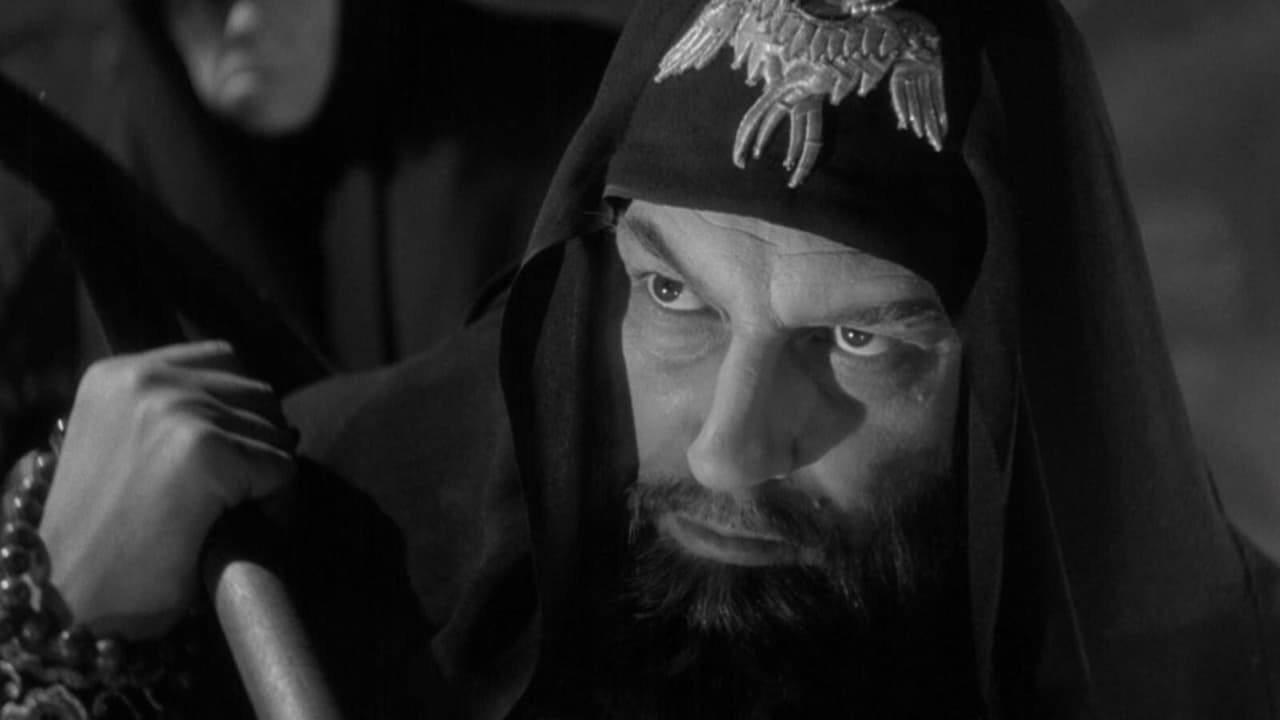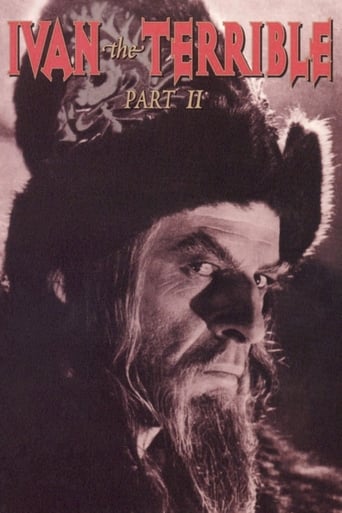

(Also see my review of Part I) Before viewing Part II, understand the term "Zemshchina".Everything is stylized. Don't though write off the acting style as hopelessly old fashioned; in the end it's quite effective. Figurative paintings decorate many of the walls; nearly every scene looks like an example of "icon painting".Shadows are used a lot: emphasize the action, or show a possible alternate reality, or portray a character's inner thoughts, or foreshadow, or undercut the action's meaning, or suggest madness.Part II is mostly B&W like Part I, but with a couple fairly short color sections. Eisenstein emphasized red and green/blue/black. Although the use of color was experimental, it's surprisingly effective.Ther's lots of cuts to other people, different vantage points, closeups, shifts to stay with the action, and so forth. But the camera only moves between shots; there aren't any dolly shots or rack focus, and arguably no tracking shots.Soviet Realism wanted films to be so simple -with few stylistic "tricks"- they could be apprehended by anyone. So Eisenstein wasn't allowed to use his own "montage" techniques. He nevertheless snuck in comparisons big-time. Comparisons are prompted when dialog and actions don't quite match; when different characters assume the same odd posture; between the real humans and the wall paintings; between film scenes and well-known paintings, between two different characters in the same frame; between characters and objects; and even between almost identical scenes several minutes apart.It's well known that Part I won the "Stalin Prize", Part II was completed but then put "on the shelf", and Part III canceled. The content of the films don't explain why; Ivan's worst abuses are never shown, and aren't even talked about much. There were significant censor-required changes even to Part I, and the Stalin Prize was hotly debated. The real difference was Part I was judged during WWII, Part II after its end.
... View MoreIn the film Ivan the Terrible Part II, directed by Sergei Eisenstein and M. Filimonova, the main character, Nikolai Cherkasov, allows the piece to be dramatic with betrayal and no success with uniting a people. By having Cherkasov play Ivan, he is allowing himself to bring a little of Sergei Eisenstein's, whose is the writer, life into the film as well. This film that was made in 1959, allowed Eisenstein to use Ivan as a way to tell his good and bad that he has experienced while growing up. In Russia, Ivan was named Tsar, and soon after events were not going smoothly for him as planned. He wanted to unite Russia, but other people had different plans or did not think it could be done. As Ivan grew old with age, his power grew and greed as well. Also, people betraying him grew. His determination for unity and his greed in doing so led to others' actions against him. This caused him to lose his wife and his best friend. In Part II, we are given a better understanding of Ivan's pain and why he does or thinks certain things. His mother was killed just saying a few words to him before the boyars took him away. "Don't trust the boyars." Ivan lived with this for the rest of his life. Ivan's strong determination to unite Russia led to him being THE TERRIBLE as everyone called him. But during the request to come to the church, he declared himself Ivan the Terrible just like everyone else did. That is when people began to worry and the ultimate betrayal came into place, because of fear of Ivan. His own aunt that had betrayed him previously like everyone else in his life, requested to have him killed so that her son could be tsar. Before this thought was even processed in his aunt's brain, Ivan knew his wife was poisoned by his aunt, but did not chose to do anything until his cousin crossed the line and laughed at him in church. The use of Ivan's eyes told it all and that is why Ivan's aunt had to have him killed. Speaking of the eyes. Many eyes on the walls are used to give us the idea that you are always being watched. Not only are they always there, but at times in the same room but at different times, the eyes will change depending on the mood of the people in the room. For example, if there is sadness amongst a main character at the movement, then the eyes on the wall will show sadness. Also, the eyes of the people are used to communicate or express themselves as well. For example, in the opening scene of Part II, the ladies used their eyes at the palace of Poland to show interest either in Ivan's old friend or just to what he was saying. In the book, Ivan the Terrible, it says the following: Eyes in Ivan seem to have a life of their own. They move almost independently of their owners. Up and down, from side to side, slowly and swiftly, eyes draw lines inside the sockets, around the spaces their bodies inhabit, and to the depths beyond" (108). The use of the eyes in this film is what interested me. I have always been fascinated with the use of the body to explain or express something without saying a word. When I worked at an airport in Chicago, sometimes I came across people that did not speak English, so I had to use gestures to communicate with them. When I succeeded they felt helpful and I felt like I was on top of the word. So the non-verbal communication with the characters is what really stuck out for me.
... View MoreAfter all these years, and Stanislavsky and our own mumbling, subliminal "method" thespians, albeit a few of them too rise above and transcend mere impersonations, Eisenstein's stylized close-up and "painterly" orchestrated set pieces, even his early use of cinema color is true art and not pastiche, elevate and transform the medium of "film." No superficial Barrymore elocutions and stridencies here. When they are present, they cut deep and true and astonishingly powerful. "Acting with the eyes" herein, in both parts of this authentic masterwork, becomes a visceral AND mental powerhouse of drama that pulses beyond mere "theater." Neither sophisticates nor cynics can sneer at this brand of "eyeball-rolling." And it all has to be attributed to the genius of Sergei Eisenstein and his collaborators. Note well he credits the cameraman second and the music scorer third, but the chef in this magical mix is the auteur, the creator, the writer/director. The two "stars," Cherkasov and Birman are, in a word, incomparable. And, in another, incredible. Talk about "power." In retrospect, what must it have been like for the genius when he met and dealt with the likes of Stalin? Now, that might be a fitting subject for some new auteur.
... View Morepart two is undoubtedly the best half. not just for the entrancing colour scenes that flash before our eyes as a most generous gift, but also because the eerier ivan never gives in to the monster he seems to have become. ivan is depicted like a forgiving evil spirit and these opposite natures make the character the puzzling critique to despots and other scum of the sort it is. one of the works of art that has haunted me since i was a teenager and hasn't lost its spell. furthermore, the invocation of the tsar's childhood offers one of the best acting performances of both movies (part 1 and 2): ivan, the young orphan. in a way, we're eventually disarmed through the strange beauty of the boy, already the tsar, already the god-like figure. the love and care deprived angel grows into the grey bearded nocturnal predator with his thugs in black hoods only to concede damnation to his aunt, conceding her a bit of well-deserved distorted muliebrity in the lush portrait of the demented pietá. but both young and adult ivans are truly and deeply the depiction of righteousness, no matter what kingdom, no matter what purposes, and revenge itself takes the frame of sacrificial salvation with the Shakespearian counter-plot against his foes. to sum up, cherkassov's strabismus and thick eyelashes are just superficial baits to a huge masterpiece of film-making.
... View More